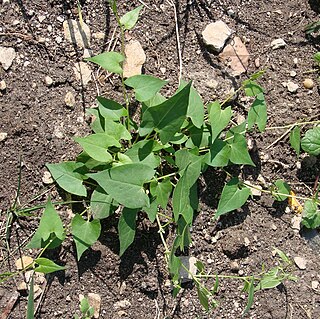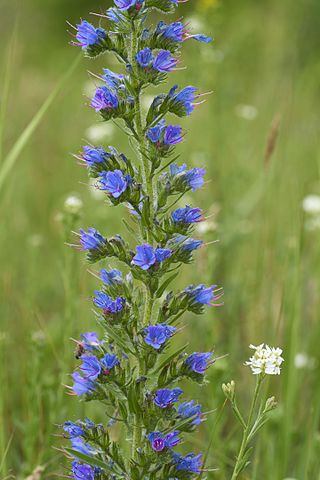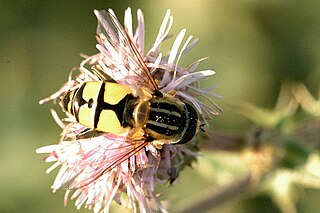
Convolvulaceae, commonly called the bindweeds or morning glories, is a family of about 60 genera and more than 1,650 species. These species are primarily herbaceous vines, but also include trees, shrubs and herbs. The tubers of several species are edible, the best known of which is the sweet potato.

Echium plantagineum, commonly known as purple viper's-bugloss or Patterson's curse, is a species of the genus Echium native to western and southern Europe, northern Africa, and southwestern Asia. It has also been introduced to Australia, South Africa and United States, where it is an invasive weed. Due to a high concentration of pyrrolizidine alkaloids, it is poisonous to grazing livestock, especially those with very simple digestive systems, like horses.

Convolvulus is a genus of about 200 to 250 species of flowering plants in the bindweed family Convolvulaceae, with a cosmopolitan distribution. Common names include bindweed and morning glory; both names shared with other closely related genera.

Fallopia convolvulus, the black-bindweed or wild buckwheat, is a fast-growing annual flowering plant in the family Polygonaceae native throughout Europe, Asia and northern Africa.

Convolvulus scammonia, known commonly as scammony, is a bindweed native to the countries of the eastern part of the Mediterranean basin; it grows in bushy waste places, from Syria in the south to the Crimea in the north, its range extending westward to the Greek islands, but not to northern Africa or Italy. It is a twining perennial, bearing flowers like those of Convolvulus arvensis, and having irregularly arrow-shaped leaves and a thick fleshy root.

Echium vulgare, known as viper's bugloss and blueweed, is a species of flowering plant in the borage family Boraginaceae. It is native to most of Europe and western and central Asia and it occurs as an introduced species in north-eastern North America, south-western South America and the South and North Island of New Zealand. The plant root was used in ancient times as a treatment for snake or viper bites. If eaten, the plant is toxic to horses and cattle through the accumulation of pyrrolizidine alkaloids in the liver.

Echium is a genus of approximately 70 species and several subspecies of flowering plant in the family Boraginaceae.

Convolvulus arvensis, the field bindweed, is a species of bindweed that is rhizomatous and is in the morning glory family (Convolvulaceae), native to Europe and Asia. It is a climbing or creeping herbaceous perennial plant with stems growing to 0.5–2 metres in length, usually found at ground level, with small, white and pink flowers.

Emmelia trabealis, the spotted sulphur, is a moth of the family Noctuidae. The species was first described by Giovanni Antonio Scopoli his 1763 Entomologia Carniolica.

Echium pininana, commonly known as the tree echium, pine echium, giant viper's-bugloss, or tower of jewels, is a species of flowering plant in the borage family Boraginaceae. It is endemic to the Canary Islands, where it is restricted to the island of La Palma. Echium pininana is an endangered species, and is listed in Appendix I to, and is therefore protected under, the Convention on the Conservation of European Wildlife and Natural Habitats. The specific epithet pininana is Latin for "small pine", though E. pininana is neither closely related to the pine, nor does it resemble that plant.

Helophilus hybridus is a hoverfly. It is a Palearctic species.

Bedellia somnulentella, the sweet potato leaf miner, is a moth in the family Bedelliidae.

HMS Convolvulus was a Flower-class corvette of the Royal Navy in World War II. She was launched in 1940, served in the Battle of the Atlantic and was scrapped in 1947.

Microsphecia brosiformis is a moth of the family Sesiidae. It is found from the Balkan Peninsula to the Crimea, southern Russia (Sarepta), Asia Minor, the Caucasus, Iran, Turkmenistan and Afghanistan.
Negotinthia myrmosaeformis is a moth of the family Sesiidae. It is found in the countries around the Black Sea, including Ukraine, southern Russia, Romania, Bulgaria and the southern part of the Balkan Peninsula. It has also been recorded from Asia Minor, northern Iraq, Armenia and Azerbaijan.

Synanthedon stomoxiformis is a moth of the family Sesiidae. It is found in most of Europe and the Middle East.

Chamaesphecia masariformis is a moth of the family Sesiidae. It is found in south-eastern Europe, Turkey, northern Iran, the Middle East, the Caucasus, southern Russia, Uzbekistan and Tajikistan.

Convolvulus erubescens, commonly known as blushing bindweed, or Australian bindweed, is a perennial herbaceous plant in the family Convolvulaceae that is endemic to Australia.
















